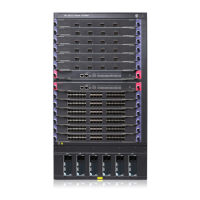355
Ste
Command
Remarks
6. Configure a filtering policy to
filter the routes to be
advertised.
filter-policy { acl6-number |
ipv6-prefix ipv6-prefix-name }
export [ direct | isisv6 process-id |
ripng process-id | static ]
Optional.
By default, BGP does not filter
routes to be advertised.
7. Configure a filtering policy to
filter received routes.
filter-policy { acl6-number |
ipv6-prefix ipv6-prefix-name }
import
Optional.
By default, the PE does not filter
received routes.
2. Configure the CE:
Ste
Command
Remarks
1. Enter system view.
system-view N/A
2. Enter BGP view.
bgp as-number N/A
3. Enter IPv6 BGP subaddress
family view.
ipv6-family N/A
4. Configure the PE as the EBGP
peer.
peer ipv6-address as-number
as-number
N/A
5. Configure route redistribution
and advertisement.
import-route protocol [ process-id ]
[ med med-value | route-policy
route-policy-name ] *
Optional.
A CE must advertise its VPN routes
to the connected PE so that the PE
can advertise them to the peer CE.
NOTE:
• After an IPv6 BGP-VPN instance is configured, exchange of BGP routes for the VPN instance is the same
as exchange of ordinary BGP routes.
• The configuration commands available in IPv6 BGP-VPN instance view are the same as those in IPv6
BGP subaddress family view. For more configuration commands in the two views, see
Layer 3—IP
Routing Configuration Guide
.
Configuring routing between PEs
Ste
Command
Remarks
1. Enter system view.
system-view N/A
2. Enter BGP view.
bgp as-number N/A
3. Configure the remote PE as
the peer.
peer ip-address as-number
as-number
N/A
4. Specify the source interface
for route update packets.
peer { group-name | ip-address }
connect-interface interface-type
interface-number
By default, BGP uses the outbound
interface of the best route to the
BGP peer.
5. Enter BGP-VPNv6 subaddress
family view.
ipv6-family vpnv6 N/A

